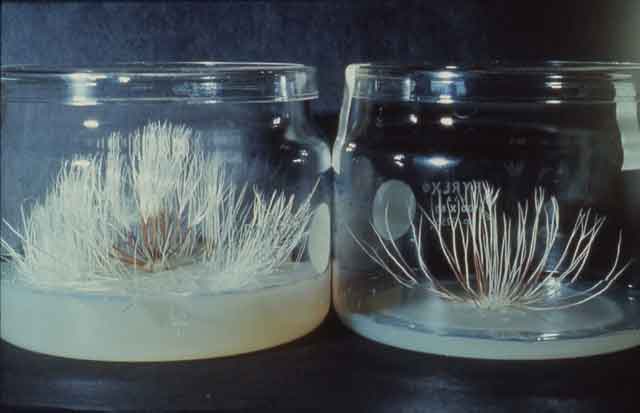

|
|
Biology Photo of the Month - September 2002Tropical FungiPhotos and text by Esther Mclaughlin |
|
Fruitbodies
of Deflexula sp. fungus growing on a twig in Costa Rica (Family
Pterulaceae, Phylum Basidiomycota)
|
|
Move
cursor over photo to see wider view
|
I have made several trips to collect, culture and further study an interesting group of wood and leaf-decomposing fungi which are related to, but very different in appearance from, mushrooms. This group, the family Pterulaceae in the Phylum Basidiomycota (mushrooms, rusts, smuts, etc.), is primarily tropical, so my travels have taken me to Costa Rica, Puerto Rico, and the warmer parts of New Zealand. The fungus shown above is a positively gravitropic, or downward growing, fungus in the genus Deflexula. This fungus may be found decomposing wood and leaves in the tropics and is only about 0.5 to 1.0 cm long. Deflexula (in culture) was the subject of an Augsburg biology student's independent research project, focussing on nutrition, fruitbody development, and spore formation.
Another, rather similar,
fungus from Bermuda is shown below growing upright (negatively gravitropically)
in culture dishes. This fungus was the start of a multi-year study of
members of the family. My husband and I named this isolate (Pterula
echo) and published several papers on its development, cytology,
classification, and reproduction. We now have more than 20 other isolates
of Pterula in culture, from various locations.

Pterula echo, a fungus from Bermuda studied and named by Augsburg biology professor Esther Mclaughlin and her husband David Mclaughlin
Both the upright
and downward-growing versions form spores on the surface of the slender
white macroscopic fruitbodies. These fruitbodies look delicate
or even fragile, but actually contain many thick-walled hyphae, making
them tough and difficult to pull apart.
Recent studies at the University of Minnesota using molecular (DNA base
sequence) evidence indicate that not only are Deflexula and Pterula
closely related (i.e., they really do belong in the same family, despite
opposite responses to gravity), but, surprisingly, they are related
to the fungi cultured by the attine ants, an intriguing group of Western
Hemisphere ants that collect plant material to feed "their"
fungi which are in turn used as food by the colony.
For more information
on attine ants and the fungi they cultivate, see: http://www.utexas.edu/cons/admin/publications/focus/spring01/p12.html,
and http://www.antcolony.org/leafcutter/leafcuttermain.htm
(this second site has some great photos and a movie of leafcutting ants
in action).
The following are links to the homepages of several attine ant researchers:
http://www.ukans.edu/~eeb/Main/currie.htm,
and http://www.biosci.utexas.edu/IB/faculty/MUELLER.HTM
See also: